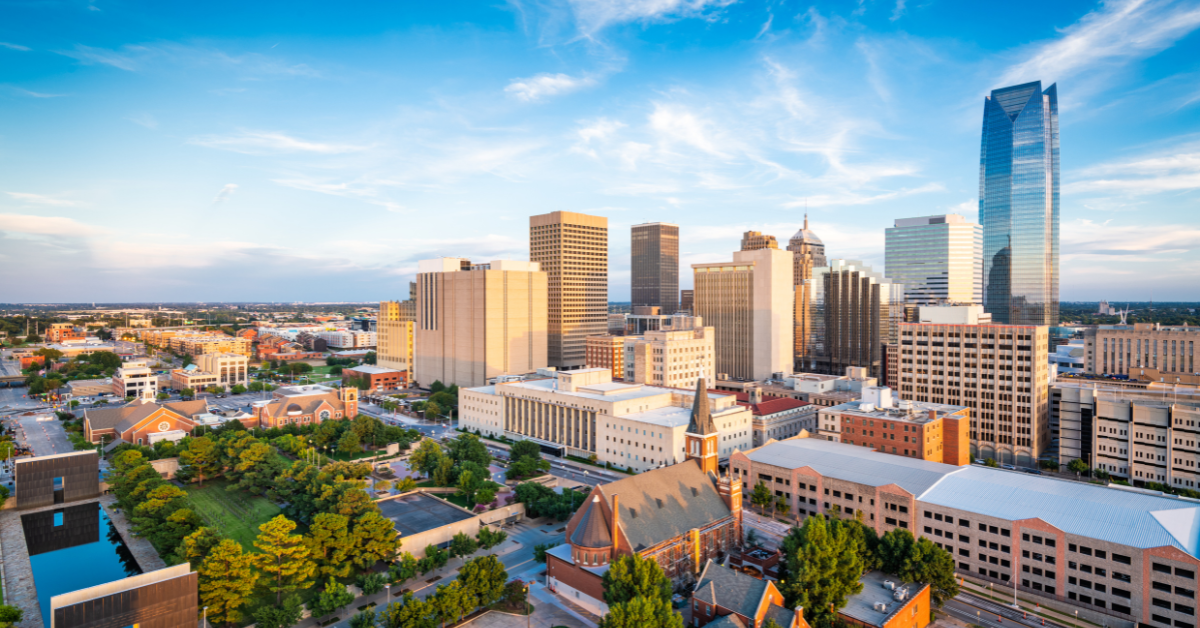Oklahoma City, the capital of Oklahoma, carries the unique kanji notation “俄克拉何馬,” a rare phonetic transcription rooted in Chinese. For Japanese people, this city is not only recognized for its role as an energy hub but also remembered through impressions of vast plains, tornadoes, and the passionate culture of sports.
The Kanji Notation “俄克拉何馬” for Oklahoma City
Origin of the Kanji Notation
“俄克拉何馬” is a phonetic transcription of “Oklahoma” that was transmitted via Chinese. The characters were not chosen for meaning but for their sound value. In Japan, the katakana form “オクラホマ” is almost always used, but this kanji notation can occasionally be found in academic documents or historical references.
Comparison of Notations
| English | Japanese (Katakana) | Kanji | Usage |
|---|---|---|---|
| Oklahoma | オクラホマ | 俄克拉何馬 | Refers to the state |
| Oklahoma City | オクラホマシティ | 俄克拉何馬市 | Refers to the state capital |
| Tulsa | タルサ | 塔爾薩 | Major city in the state |
Features and Appeal of Oklahoma City
Role as the State Capital
Oklahoma City is the political and economic center of Oklahoma. The State Capitol and government institutions are concentrated here. With a population of about 700,000 and a metropolitan area exceeding 1.3 million, it stands as one of the key cities in the American South.
Hub of the Energy Industry
The city thrives on its oil and natural gas industries, with many major companies headquartered here. This stable economic base has supported the region’s development, earning the city the title of “Energy Capital of America.”
Main Industries (Overview)
| Sector | Share | Characteristics |
|---|---|---|
| Oil & Natural Gas | ~30% | Headquarters of major firms |
| Services | ~25% | Healthcare and education |
| Manufacturing | ~20% | Aircraft parts, farm equipment |
| Tourism & Culture | ~15% | Museums, events, leisure |
| Others | ~10% | IT, logistics, diverse fields |
Tourism and Cultural Attractions
The city hosts many cultural and historical landmarks. In particular, the National Cowboy & Western Heritage Museum and the Oklahoma City National Memorial leave strong impressions on visitors.
Tourist Attractions
| Site | Features | Why Known to Japanese |
|---|---|---|
| National Cowboy Museum | Exhibits Western history | Linked to Western films & music |
| Bricktown | Dining and entertainment hub | Popular modern tourist district |
| National Memorial | Tribute to 1995 bombing victims | Widely covered in Japanese media |
The Image Japanese People Have of Oklahoma City
Vast Nature and Open Plains
The city symbolizes “America’s great outdoors” for many Japanese people. Wide plains, expansive skies, and connections to country music or Westerns give it a pastoral image.
Impression of Natural Disasters
Oklahoma belongs to the Tornado Alley, a region prone to severe tornadoes. Thus, many Japanese associate the city with disaster, influenced by news footage and reports.
Tornado Records
| Year | Severity | Characteristics |
|---|---|---|
| 1999 | F5 | Winds exceeded 500 km/h |
| 2013 | F5 | Devastated Moore, OK |
| 2021 | F3 | Widespread power outages, housing damage |
Recognition as a Sports City
In recent years, Oklahoma City’s image for Japanese people is strongly tied to sports enthusiasm, especially the NBA team Oklahoma City Thunder.
Oklahoma City Through the Lens of Sports
NBA: Oklahoma City Thunder
Relocated from Seattle in 2008, the Thunder have become the pride of the city. During the early 2010s, superstars Kevin Durant and Russell Westbrook turned the team into a powerhouse, gaining global recognition and winning Japanese fans as well.
Timeline of the Thunder
| Era | Key Players | Highlights |
|---|---|---|
| 2008–2010 | Kevin Durant | Team foundation established |
| 2011–2016 | Durant, Westbrook, Harden | Reached NBA Finals |
| 2017 onward | Westbrook, later Chris Paul | Transition and rebuilding |
The Impact of College Sports
The University of Oklahoma’s football team, the Sooners, is one of the most successful programs in the U.S. Game days create a festival-like atmosphere, and the sport has become a cultural identity for the state.
Sports and Community
In Oklahoma City, sports go beyond entertainment—they foster unity and civic pride. Families attend games together, and arenas serve as gathering places that strengthen community bonds.
Conclusion
The kanji notation “俄克拉何馬” is a unique phonetic transcription of Oklahoma City, rarely used in Japan but culturally intriguing.
For Japanese people, Oklahoma City is strongly associated with “vast nature,” “tornado-prone land,” and “a vibrant sports city.” Above all, the Thunder’s success and the passion for college football embody the city’s energy and vitality.
Oklahoma City is not only an energy hub but also a place that treasures history, celebrates culture, and unites through sports. Even though it lies far from Japan, it continues to stand out through its presence in international news, natural challenges, and sports achievements.






